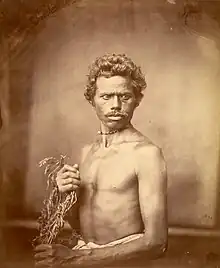কৈবৰ্ত্ত | |
|---|---|
 Kaibarta fisherman from East Bengal in 1860s | |
| Regions with significant populations | |
| India (Assam, West Bengal, Tripura) Bangladesh (Mymensingh, Dhaka, Sylhet and Chittagong divisions) | |
| Assam | 5,81,559 (c. 2001) |
| Languages | |
| Assamese • Bengali • Odia | |
| Religion | |
| Hinduism • Buddhism | |
Jalia Kaibarta (or Jaliya Kaibartta, or: Jāliya Kaibbarta, possibly also: Jalia Kaibartya) is a community comprising people of low ritual status, fishermen, who later acquired respectable caste identities within the larger Hindu fold, helped by their commercial prosperity and Vaishnavite affiliations, through Sanskritisation.[1] They are traditionally engaged in the occupation of fishing and originally belonged to Assam, West Bengal, Odisha and eastern Bihar along with Bangladesh, Nepal, Bhutan. The Kaibartas were initially considered a single tribe divided into two groups, Haliya and Jaliya Kaibarta, where the Haliya Kaibarta are considered to be superior than the latter.[2] Jalia Kaibartas are categorised as a Scheduled Caste[3][4][5] and are the second largest among the 16 SCs in Assam under the name Kaibartta, Jaliya.[6][7] Many of the Jalia Kaibarta under the influence of Garamur satradhikar gave up their traditional occupation of fishing and divided themselves into – mach mara and mach na-mara.[8]
In Brahmavaivarta, a Kaibarta is said to be born to a Kshatriya father and a Vaishya mother, while other consider Kaibarta to be a Hinduised word of Kevatta which refer to a class of fishermens in the Buddhist Jatakas.[9] They are also claimed to have their own priest.[9]
The first proto-Assamese manuscript, in the form of Caryapādas, was written by a Buddhist priest, known in Tibetan language as Lui-pā, who is identified with Matsyendranātha, a member of the fishermen community of mediaeval Kāmarūpa, which later became Kaibartas.[10][11]
Medieval Oriyan poet and Vaishnav saint Achyutananda Dasa wrote kaibarta Gita which narrates the origin, growth, functions and roles of this community.[12][13][14]
In Bangladesh, Kaibartas are inland fishermen and are the main Hindu fishing community in Haor areas. Their population here is decreasing steadily with emigration to India.
Notable people
- Bhupen Hazarika, musician, playback singer, lyricist, poet, actor and filmmaker from Assam, awarded with the Dadasaheb Phalke Award and the Bharat Ratna[15]
- Jayanta Hazarika, musician, playback singer from Assam[15]
See also
Notes
- ↑ The census of 1901 interpreted the act of renaming as a ‘‘refusal of those at the bottom of the social scale to acquiesce in the humble positions assigned to them.’’. For Assam’s Dom fisher caste, previously at the lowest end of the ritual hierarchy, this refusal took the form of claims to Aryanist belonging through the new names of Nadiyal and Kaibarta. In colonial Assam the upper echelons of Dom society succeeded for the most part in acquiring new, respectable caste identities within the larger Hindu fold, helped by commercial prosperity and Vaishnavite affliations. Sharma, Jayeeta. Empire's Garden: Assam and the Making of India (PDF). Duke University Press. p. 214.
- ↑ "In Lower Assam the Keots are divided into two main endogamous groups, halova and jalova Keots, or agriculturalists and fishermen, the former being held superior than the latter"(Cantile 1980:235)
- ↑ Atal, Yogesh (1981). Building A Nation (Essays on India). Diamond Pocket Books (P) Ltd. p. 118. ISBN 978-8-12880-664-3.
- ↑ Venkatesh Salagrama; Food and Agriculture Organization of the United Nations (30 December 2006). Trends in Poverty and Livelihoods in Coastal Fishing Communities of Orissa State, India. Food & Agriculture Org. p. 80. ISBN 978-92-5-105566-3. Retrieved 18 April 2012.
- ↑ Chakrabarty, Bidyut (1997). Local Politics and Indian Nationalism: Midnapur (1919-1944). New Delhi: Manohar. pp. 62–67.
- ↑ India Commissioner for Scheduled Castes and Scheduled Tribes (1969). Report. Manager, Government of India Press. p. 122. Retrieved 14 January 2020.
- ↑ Indian Association of Social Science Institutions Quarterly. Indian Association of Social Science Institutions. 2003. pp. 104, 111. Retrieved 14 January 2020.
- ↑ (Cantile 1980:17)
- 1 2 Dutta 1985, p. 35.
- ↑ Dasgupta, Shashibhushan (1946). Obscure Religious Cults, Calcutta University Press, Calcutta, p. 384-385, Internet Archive copy; third edition: Firma KLM Private Limited, Calcutta 1960, Internet Archive copy; fifth edition: Firma KLM Private Limited, Calcutta 1995, ISBN 81-7102-020-8
- ↑ Ayyappapanicker, K. & Akademi, Sahitya (1997). Medieval Indian literature: an anthology, Volume 3. Sahitya Akademi. ISBN 81-260-0365-0, ISBN 978-81-260-0365-5, (accessed: Friday 5 March 2010)
- ↑ Orissa (India); Behuria, N. C. (1990). Orissa State Gazetteer. Gazetteers Unit, Department of Revenue, Government of Orissa.
- ↑ "The Kaibartas of Odisha". Odisha News, Odisha Latest news, Odisha Daily - OrissaPOST. 22 April 2019. Retrieved 17 November 2022.
- ↑ Mukherjee, Sujit (1998). A Dictionary of Indian Literature: Beginnings-1850. Orient Blackswan. p. 4. ISBN 978-81-250-1453-9.
- 1 2 "Revolutionary Artist Dr. Bhupen Hazarika: Voicing the Silence of the Subaltern" (PDF). Asian Journal of Humanities and Social Sciences: 9.
References
- Dutta, Shristidhar (1985). The Mataks and their Kingdom. Allahabad: Chugh publication.
- Cantile, Audrey (1980). CASTE AND SECT IN AN ASSAMESE VILLAGE (Ph.D.). University of London.
